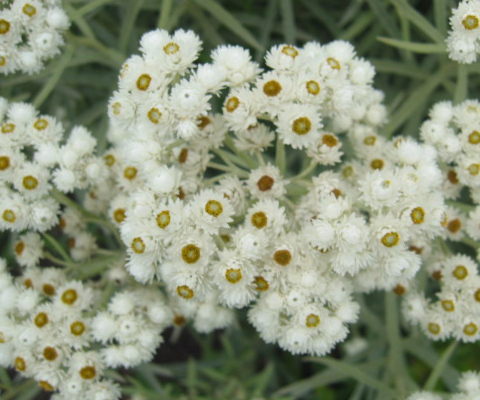
Scientific Name
Anaphalis margaritacea
Description
Pearly everlasting can grow to up to nearly a metre tall and can eventually bush out equally as wide. The clusters of white flowers have yellow centres and bloom for many weeks from mid-summer through to early fall. The leaves are long and narrow with a silvery hue, thanks to the fine hairs that cover its leaves and stems.
Photo Gallery
 |
 |
 |
Range
This plant is native to every province in Canada as well as the Yukon and the Northwest Territories.
Primary Ecosystem Roles
The American Lady (Vanessa virginiensis) and Painted Lady (Vanessa cardui) butterflies uses pearly everlasting as a host plant for its young. Despite the caterpillars using the plant for food, the damage is usually minimal and the plant fully recovers. The flowers are magnets for pollinators such as butterflies and bees, while the plant is said to repel some insects that gardeners may consider bothersome.

|
|
Click to enlarge | Photography by Sarah Coulber |
By Sarah Coulber
If you’re looking to grow more drought-tolerant plants and you want something a little different, consider Anaphalis margaritacea. Native to every province in Canada as well as the Yukon and the Northwest Territories, its unique look and tolerance for poor soil could make it the perfect choice for your garden.
Uses
As for human use, pearly everlasting is popular for dried flower arrangements. Cut stems before the flowers fully open and hand upside down for several weeks. It has also been used medicinally for treating bruises, sprains and swellings and even bronchitis.
Caution: We are not recommending the use of these plants for medicinal or food purposes. Many plants are poisonous or harmful if eaten or used externally. The information on food and medicinal value is only added for interest. The accuracy of this information has not been tested.
Propagation
If you wish to share your everlastings, keep your eye out for little plants that spring up around the main plant and pot up or transplant them. If you hope to grow them from seed, however, sow the seeds in the fall, when they would naturally fall to the ground, and cover them with a light layer of soil or sand. Alternatively, start indoors several weeks before the last frost. Harden off before planting in the ground.
Care
These perennials thrive in full sun and average soil and are typically easy to take care of.
For more information on native plants that might suit your garden, check out our Native Plant Encyclopedia






